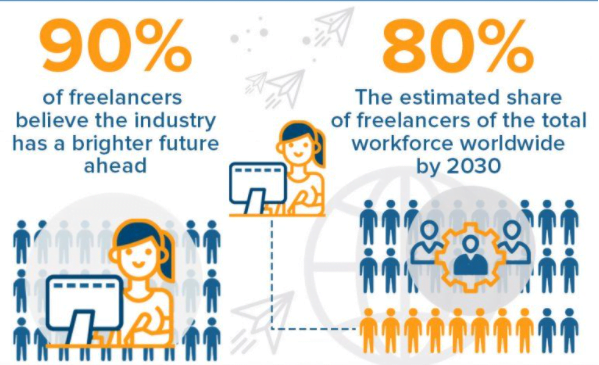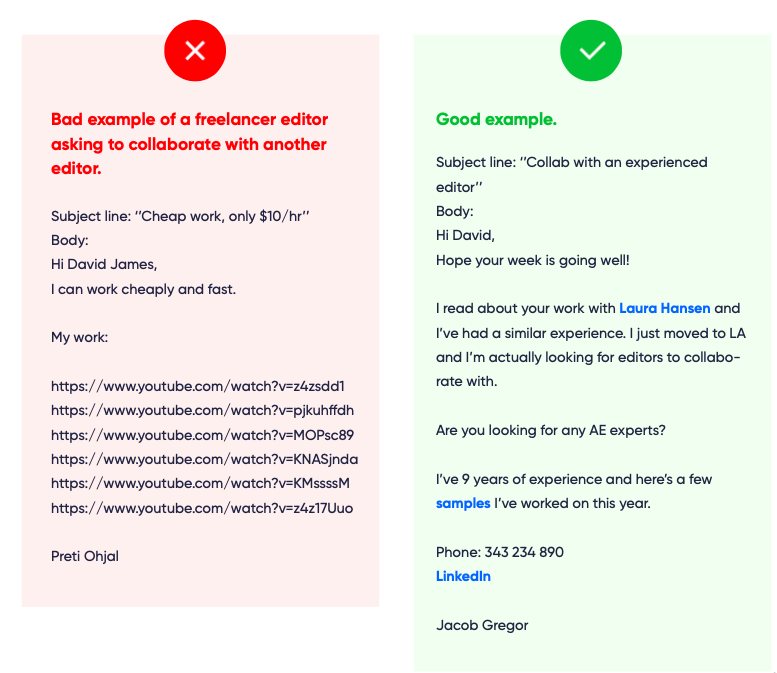Want to join the ranks of freelancers? The freelance revolution has been ongoing for some time and it’s gaining speed especially because of COVID-19.
In the US alone, there are 58 million freelancers right now and they’re set to represent the majority of the workforce by 2027.
There are several reasons why this work model is so lucrative.
For a start, you’re in charge of your professional life – you choose the clients to work with, your rates and the projects you’re going to bid on.
Freelancers have also proven their ability to earn good income. US stats suggest that about 31 percent of freelancers earn 75,000 dollars or more per year.
If they need to 25 percent of freelancers report being capable of landing a new project within 24 hours.

And most importantly – 60 percent of freelancers who left a regular office job report earning more than they did before.
All of this is very exciting but making the switch from regular employment to freelance work isn’t that easy.
What does it take to make a successful transition from your office job to freelancing?
If you’re eager to give freelancing a try but you don’t know how to, the following guide is just for you.
It will outline some of the most important first steps that will help you set yourself up for success.
Step 1: Choose a Lucrative Nice
The most important first step is determining what kinds of services you’re going to offer.
You’re already facing some really tough competition from well-established freelancers.
Thus, you need to find your niche, the one that will help you build your reputation quickly and start landing gigs.
Here’s a simple example to illustrate the concept.
If you decide to look for regular content writing jobs, you’ll probably have to compete against hundreds of other writers.
So, take some time to think about your specialized skills.
Do you have experience as a fiction writer?
Or maybe you’ve worked for a legal company and you understand the specifics of crafting legal texts and documents?
Niche services are much easier to market and they’ll often be more fruitful than generic freelancing jobs.
Doing the research to discover a lucrative niche in advance can help you land an amazing project really fast.
Don’t just rush to get started. Take your time and the market analysis will pay off.
Step 2: Make Sure You Have Everything Needed to Begin Freelancing
As someone else’s employee, you don’t have to think about the essentials required to do your job.
When you start freelancing, you’ll be responsible for every single aspect of business operation.
That means making sure you have everything needed to give clients an amazing outcome.
Some of the essentials you may want to secure in advance include:
- A reliable computer or laptop
- Internet connection
- The software needed to do your job (text processing, spreadsheet, video editing programs, etc.)
- Comfortable furniture – at least a good desk and a comfortable chair
- Additional equipment (headphones, external hard drives, speakers, camera, lights etc.)
Also, think about investing in courses and training opportunities to enhance your skill set.
Investing in know-how is one of the biggest things if you want to stay competitive in the long run.
Learning new professional skills will also help you broaden the scope of services you offer.
These services have to be in sync or comparable of course.
Step 3: Legal setup and Documents
This is a step many people skip because they’re not confident in their freelance business yet or they’re just trying out things and forget to set up their business properly later.
However, you have to understand an important fact. Once you start working on the first project, you will have to pay taxes for the income that you generated.
Most tax authorities don’t care if you earned only $1,000 or if you secured a good annual income.

You’ll need to operate legally, maintain financial documentation and pay your taxes.
If you’re serious about freelancing, this is something you’ll once again need to address in advance.
Consulting a lawyer and an accountant can be helpful.
Try to understand the differences between being registered as a private company owner, a sole proprietor or a limited partner.
Each of these legal entities comes with pros, cons and responsibilities.
The right one will help you minimize taxes and allow you to work without worrying about fees and penalties.
Don’t wait for money to start coming in before handling registration.
Depending on your location, the process could be somewhat lengthy.
Also, most taxation authorities expect you to have some sort of business registration before you begin working with clients.
Step 4: Start Working on Your Online Presence
Let’s get things straight – clients will do some online research before hiring you.
What information about you will they be able to find right now?
You have to take care of your digital reputation and brand.
Building a personal website is the first step and you don’t need specialized knowledge to accomplish the goal.
Platforms like WordPress make it very easy to throw a really cool-looking website together.
Feature your biography, your portfolio or at least a few work samples.
It’s also a good idea to provide contact details so that clients can get in touch with you directly.
Other things you can do to build your online freelance reputation include:
- Start a blog and write content about your niche
- Update your LinkedIn profile
- Start a YouTube channel (you don’t need expensive equipment and editing knowledge to be successful)
- Sign up for freelance websites like Upwork and Fiverr
- Write a few guest posts for niche websites that accept such content
These are just a few suggestions and you can do a lot more to build your online presence in a meaningful way.
And remember – each time you upload something, you provide potential clients with information.
This is why you need to be careful with personal stuff you post online.
At least tweak the privacy settings of your social media to only let friends see what you’re posting.
Step 5: Creating Proposals and Start Applying
Now that you’ve handled the financial, legal and marketing side of things, you’re ready to start accepting projects and clients.
Your freelance proposals need to be carefully planned and personalized. Don’t just come up with a generic cover letter that you copy and paste each time.
Also, be selective about the jobs you apply to.
You may think that submitting hundreds of applications is the best way to land a gig.
This isn’t the case. If you don’t pay enough attention to your applications, you’ll end up with subpar presentations clients aren’t going to be impressed by or directly in the spam filter.
Instead, sort through the jobs and filter the ones that match your knowledge in the best way.

Work on personalized and impressive cover letters.
Even if you don’t get noticed right off the bat, this is the best approach to get to work on the kinds of projects you can charge more for and specialize in.
Don’t be afraid of stepping in confidently, even if you’re a newbie.
You may have no freelance experience but you definitely come with your career background.
Don’t undersell yourself or allow clients to bully you into low paying jobs.
Also, you should never offer free samples (a major red flag).
Step 6: Work on Building and Maintaining Relationships
Most business owners will tell you one thing – it takes a lot more time and money to build relationships with new clients than to maintain existing ones.
Landing a few jobs isn’t the final step – it’s just the beginning.
You’ll now have to deliver beyond client expectations. If you do, the respective customer is likely to come back to you when in need of professional assistance.
Working super hard to offer great results can also contribute to referrals.
Most freelancers have a few of those golden clients that bring in extra work.
View your relationship with a client as a long-term one, even if it’s a one off project.
Happy clients leave positive reviews and they’ll also recommend you to others in need of similar services.
This creates an avalanche-like effect that will give you financial stability and a number of secure long-term projects.
Customer service is always super important but especially in freelancing.
Remember – there are many other freelancers out there who are willing to offer clients lower prices and unbelievable turnaround time.
To beat them, you have to be professional and you also have to offer the personal touch that will win clients over once and for all.
Obviously, these six steps give you a simplified idea of what it’s like to start a freelance career.
There’s a lot more you’ll need to handle – contracts, time tracking, invoicing, pitching, add-ons etc.
There are also some extra industry-specific steps you’ll also be responsible for.
Always remember to be strategic, do your research in advance and come up with an action plan.
Treating freelance work as a serious opportunity can turn it into a long-term business and a way to earn a solid income.
If you just see it as a side gig, that’s probably what it’s going to be. Think big, put the effort in and continue focusing on self-improvement.








Comments 3
Pingback: Being a Part-Time Freelancer vs. Quitting Your Day Job - Taspin.com
Pingback: Becoming a Freelancer with No Experience: How to Get Started - Taspin.com
Pingback: is Cold-Emailing a Good Idea to Get New Clients? - Taspin.com